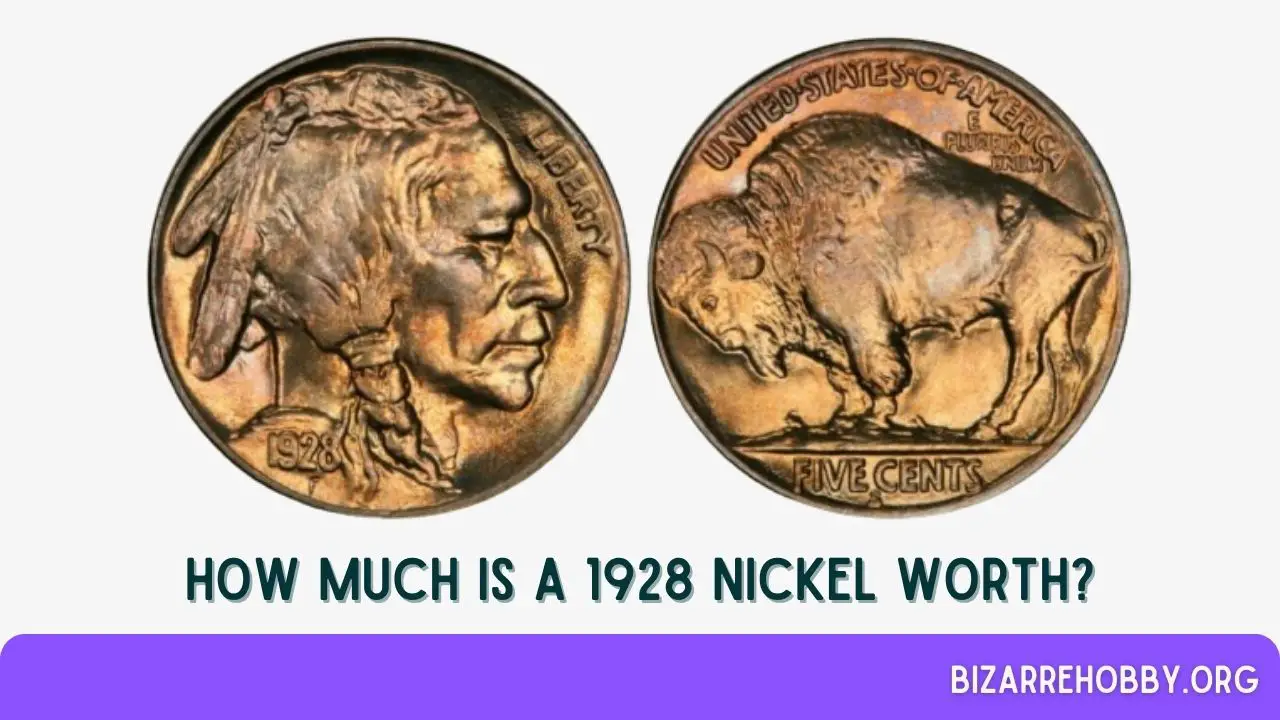Often referred to as Indian Head Nickels or Buffalo Nickels, these coins are more accurately described as featuring a Native American on the obverse and a bison on the reverse. As we try to understand the 1928 Buffalo Nickel value, let’s clarify these terms and explore the factors influencing their worth.
Table of Contents
- Value Charts for 1928 Buffalo Nickel
- Historical Significance of the 1928 Buffalo Nickel
- Design of the 1928 Buffalo Nickel
- Grading Guide for 1928 Buffalo Nickel
- 1928 Buffalo Nickel Value Guides
- Rare 1928 Buffalo Nickel Error List
- Where to Sell Your 1928 Buffalo Nickel?
- What to look for in the 1928 Buffalo Nickel?
- FAQs On 1928 Buffalo Nickel Value
- Final Thoughts
Value Charts for 1928 Buffalo Nickel
| Coin | AU 50 | MS 60 | MS 62+ | MS 64+ | MS 66+ | MS 67+ |
|---|---|---|---|---|---|---|
| 1928 No Mint Mark Buffalo Nickel | $30 | $55 | $75 | $275 | $1,250 | $16,500 |
| 1928-D Buffalo Nickel | $60 | $85 | $150 | $340 | $6,500 | NA |
| 1928-S Buffalo Nickel | $125 | $400 | $650 | $1,700 | $23,500 | $67,500 |
Historical Significance of the 1928 Buffalo Nickel
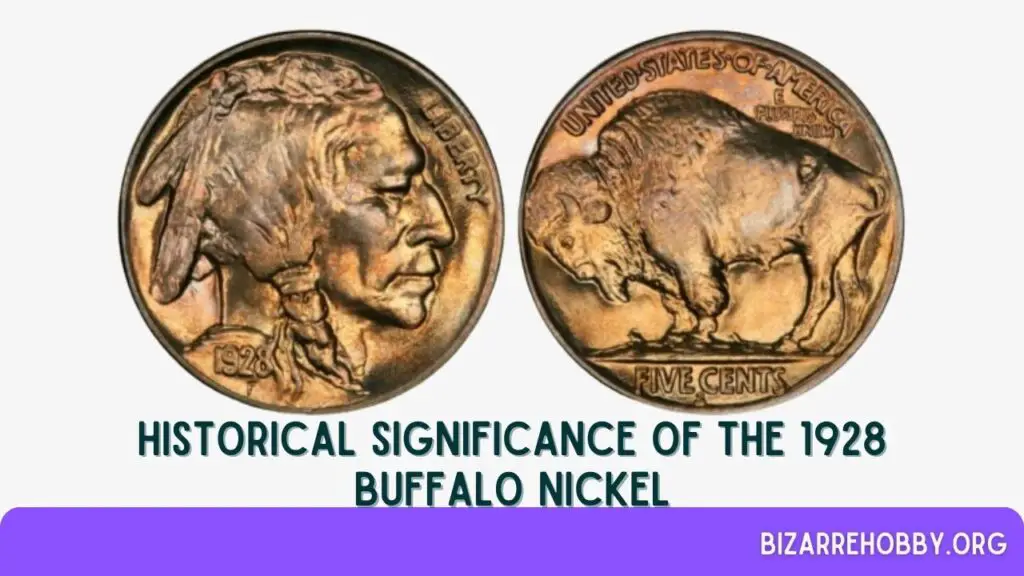
The 1928 Buffalo Nickel has a rich history rooted in the early days of American coinage. Initially, settlers in America used foreign coins, with the Spanish Silver Dollar being particularly popular.
When the U.S. began minting its own coins, it employed engravers trained in Scotland, who brought with them a focus on simplicity and durability. This approach ensured that dies could be reused for longer periods, a principle that continued with subsequent American-born mint engravers.
The lineage of engravers included the Barber family, with John, William, and Charles Barber contributing significantly to U.S. coin design.
However, a shift occurred in 1904 when President Theodore Roosevelt sought to infuse American coins with the artistic flair of ancient Greek and Roman designs. He enlisted Augustus Saint-Gaudens, whose influence led to more sculptural and high-relief coin designs.
Following Saint-Gaudens’ death, his protégés continued his work. Victor David Brenner designed the Lincoln Penny, and James Earle Fraser created the Buffalo Nickel.
Fraser’s design was selected to replace the Liberty Head Nickel, and despite bureaucratic delays, the Buffalo Nickel was finally released in 1913.
The Problem with Buffalo Nickels
The Buffalo Nickel, while popular with the public, posed significant challenges for the mint. Its intricate design required multiple strikes to achieve the desired detail, leading to rapid die wear.
This resulted in frequent die replacements and coins with worn features, such as missing dates and blurred mint marks. The high points of the coin, including the bison’s legs, were particularly susceptible to wear and die re-polishing.
It’s important to note that the animal depicted on the reverse is a bison, not a buffalo. Bison are native to America, whereas buffaloes are found in Africa and Asia. Bison have distinctive features, including frizzy fronts, hunched shoulders, and smaller horns compared to buffaloes.
Design of the 1928 Buffalo Nickel
Understanding the design and technical aspects of coin descriptions can enhance your appreciation and evaluation of the 1928 Buffalo Nickel. Here are the key features and terms:
- Obverse: The front side of the coin, often referred to as the “heads” side.
- Reverse: The back side of the coin, known as the “tails” side.
- Edge: The thin side of the coin, which can sometimes have ridges called reeds.
- Rim (or Collar): The raised border around the coin.
- Mottos (or Legends): The inscriptions or words on the coin.
- Device: The main image or design on the coin.
- Field: The background area of the coin.
- Planchet: The blank metal disc before it is struck into a coin.
Obverse Design of 1928 Buffalo Nickel

The obverse features a detailed portrait of a Native American man adorned with three feathers in his hair. The third feather is partially obscured, visible only at the nape of his neck. The date of minting and the initial “F” for the designer, James Earle Fraser, are located at the bottom. The word “Liberty” is inscribed on the upper right, in front of the man’s face.
Reverse Design of 1928 Buffalo Nickel
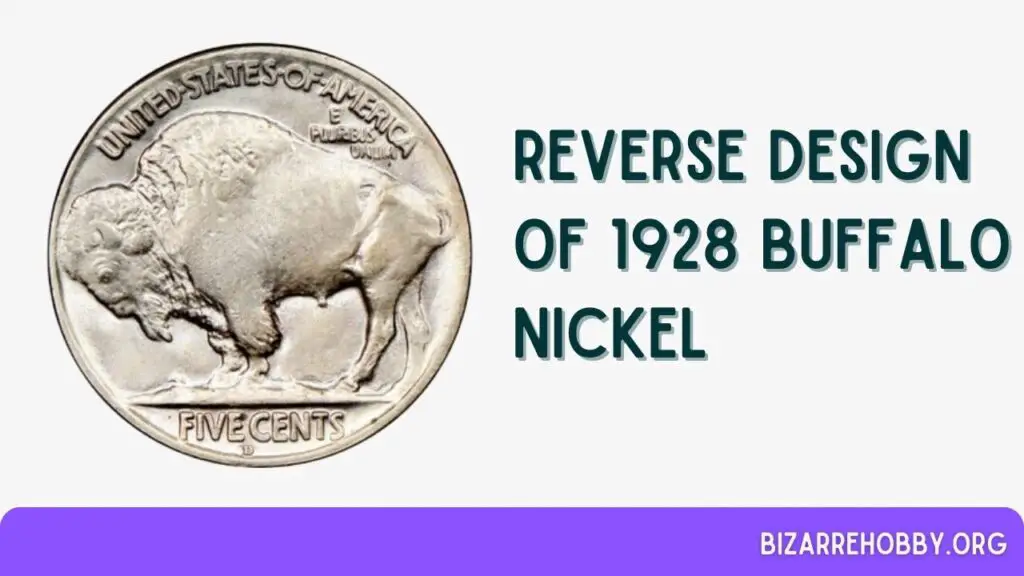
The reverse showcases a bison facing left. The top of the coin bears the inscription “United States of America,” with the motto “E Pluribus Unum” positioned above the bison’s back on the upper right. The coin’s denomination, “Five Cents,” is displayed at the bottom, with the mint mark situated below the denomination.
Technical Specifications of 1928 Buffalo Nickel
- Composition: 75% Copper and 25% Nickel.
- Diameter: 21.21mm (0.835 inches).
- Edge: Smooth or plain, without reeds.
- Weight: 5 grams.
- Minting Period: The Buffalo Nickel series was minted from 1913 to 1938. Earlier versions featured the bison standing on a hill.
Grading Guide for 1928 Buffalo Nickel
Due to the delicate features of the Buffalo Nickel, finding high-grade specimens is challenging. These coins are typically graded using the Sheldon Scale, which ranges from 1 (Poor) to 70 (Mint State).
Uncirculated coins fall between 50 and 58, often referred to as About Uncirculated (AU). Mint State coins, ranging from 60 to 70, are particularly rare.
| Sheldon Scale | Grade |
|---|---|
| 1 | Basal State-1 |
| 2 | Fair |
| 3 | Very Fair |
| 4, 5, 6 | Good |
| 7, 8, 10 | Very Good |
| 12, 15 | Fine |
| 20, 30 | Very Fine |
| 40 | Extremely Fine |
| 50 | About Uncirculated |
| 60 | Mint State |
| 65 | Mint State |
| 70 | Mint State |
For an accurate assessment of your coin’s value, refer to our detailed grading guide for Buffalo Nickels.
1928 Buffalo Nickel Value Guides
All Buffalo Nickels were produced as regular strikes, intended for everyday transactions. The U.S. Mint did not produce proofs or collectibles in this series, likely due to the complexity of the design. In 1928, Buffalo Nickels were minted in Philadelphia, Denver, and San Francisco. Let’s examine the values of these coins from each mint.
1928 No Mint Mark Buffalo Nickel Value
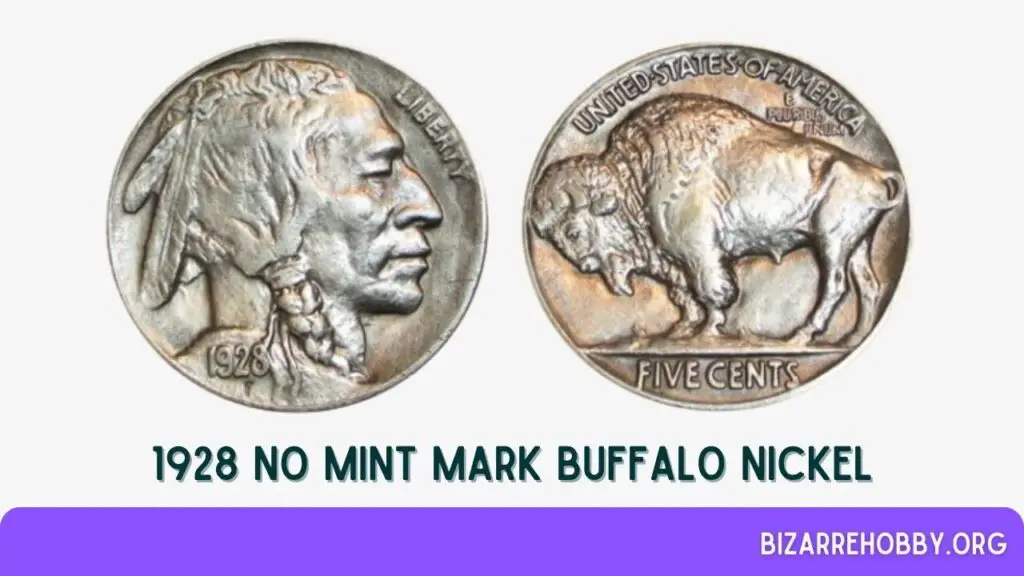
In 1928, the Philadelphia Mint produced 23,411,000 Buffalo Nickels without mint marks. On August 14, 2004, an MS 67 coin sold for $11,500. As of April 2024, PCGS has graded over forty coins at this level, valuing them at $4,750.
Four coins have achieved an MS 67+ grade, the highest known, estimated at $16,500 in April 2024. The most recent sale of an MS 67+ was in November 2019 for $11,400.
MS 67 coins have sold for $3,300 to $3,800 between 2021 and 2023. NGC-graded MS 67 coins have lower values, selling for $2,400 to $2,600 in 2023. MS 66 coins are valued at $800, with over two hundred submissions to PCGS.
MS 66+ coins, rarer with only 55 submissions, are priced at $1,250. An MS 60 coin is valued at $55 in 2024.
1928-D Buffalo Nickel Value
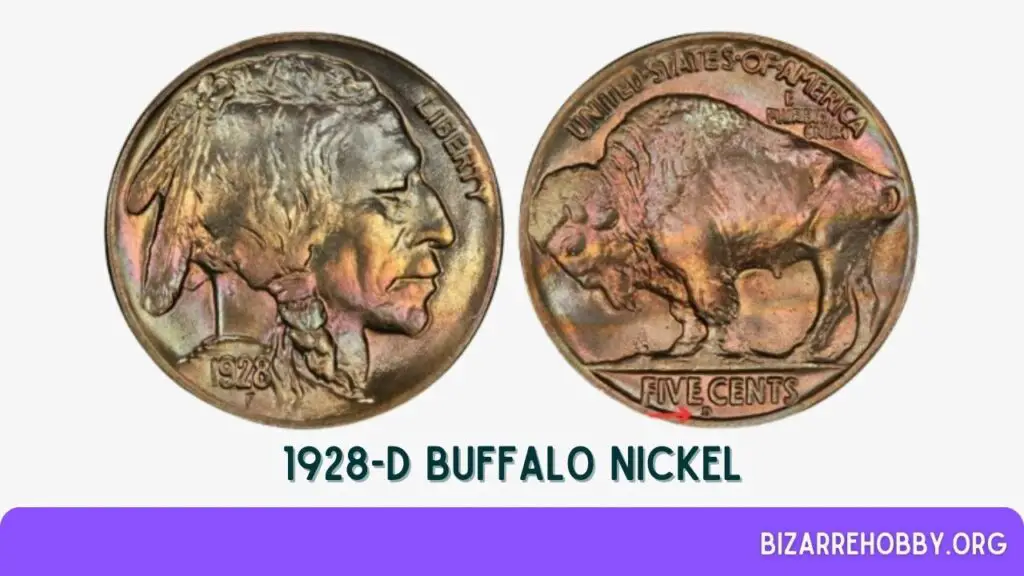
The Denver Mint produced 6,436,000 Buffalo Nickels in 1928, all marked with a “D”. Due to their lower mintage, these coins have higher resale values. On January 3, 2012, an NGC-graded MS 67* sold for $17,250.
PCGS has not graded any MS 67+ coins, but the highest grade they have seen is MS 67, valued at $30,000 in April 2024. Seven MS 67 coins are estimated at $6,500 each.
MS 66 coins, with nearly seventy submissions, are valued at $3,600. MS 65 coins, more common with almost 500 submissions, are valued at $550. MS 65+ coins, rarer with under fifteen submissions, are priced at $900. An MS 60 coin is valued at $85.
1928-S Buffalo Nickel Value
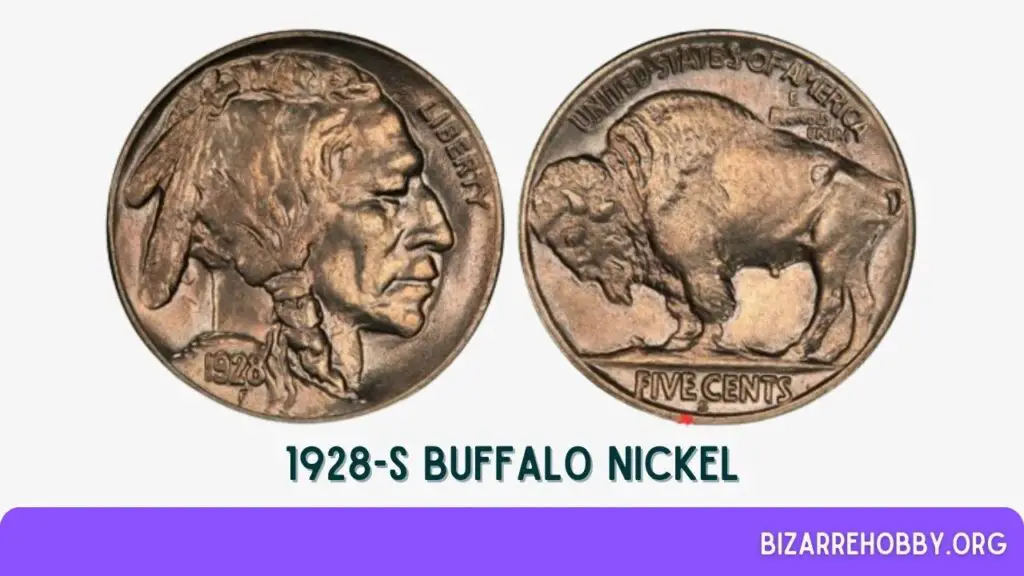
In 1928, the San Francisco Mint produced 6,936,000 Buffalo Nickels with an “S” mint mark. On July 1, 2009, an MS 67 coin sold for $46,000. Only two coins are known in this grade, valued at $46,500 in April 2024. MS 67+ coins are estimated at $67,500, though none have sold yet.
Two MS 66+ coins are valued at $23,500. Twenty MS 66 coins are valued at $15,000. MS 65+ coins, influenced by the abundance of MS 65 coins (almost 100), are valued at $4,750.
An MS 60 coin is valued at $400, with only six known. MS 62 coins, more common with almost ninety submissions, are valued at $500. Lower-grade coins also hold value: VG 10 is $10, VF 20 is $20, and VG 30 is $30.
Rare 1928 Buffalo Nickel Error List
When a new coin is released, experts meticulously examine them for mint errors within the first 30 days, as these early mistakes, known as FS (First Strike) errors, can significantly increase a coin’s value.
Let’s delve into the notable 1928 Buffalo Nickel errors, starting with the FS-401 and exploring other valuable mint mistakes.
1928-S Buffalo Nickel 2-Feathers Error FS-401

Buffalo Nickel dies had a notably short lifespan, leading mint workers to frequently re-polish them to extend their usability. This re-polishing sometimes inadvertently removed design elements, such as the third feather on the obverse or the legs on the reverse. A 1928-S Buffalo Nickel with the 2-Feathers Error in MS 63 grade sold for $2,040 in 2019.
1928-S Buffalo Nickel Ragged Clipped Planchet Error
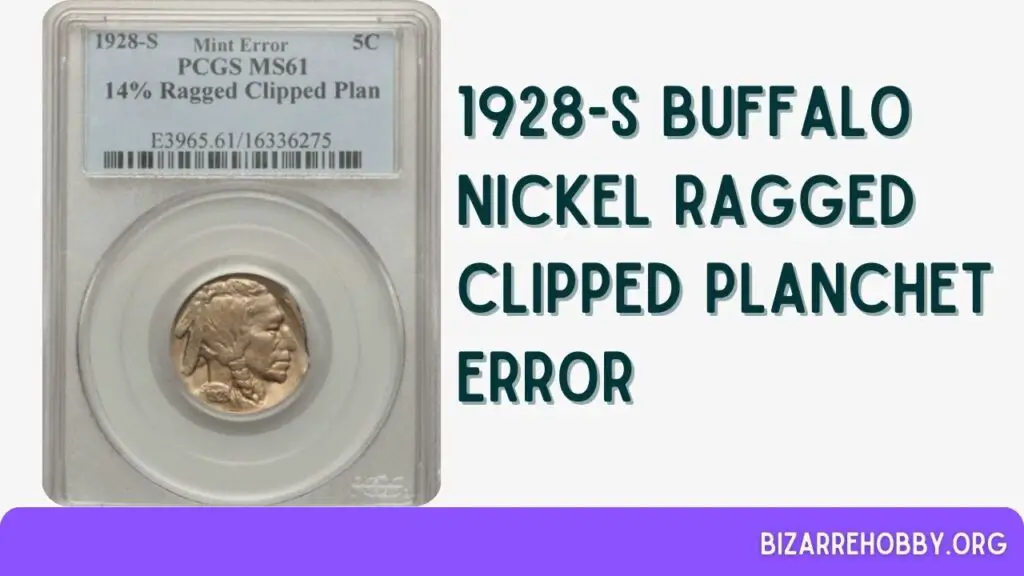
Coins are produced from metal sheets fed into a blanking machine that punches out blank discs called planchets. Occasionally, coins are struck on the leftover metal, resulting in straight or curved clips where the holes were. A 1928-S Buffalo Nickel with a ragged clipped planchet in MS 61 grade sold for over $160.
1928 [P] Buffalo Nickel Struck 15% Off-Centre Error
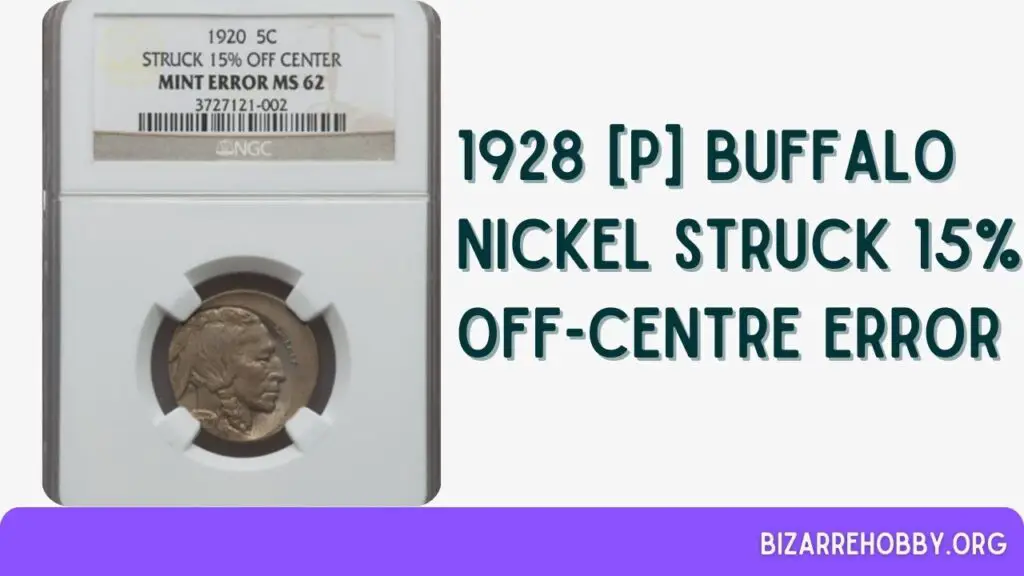
During the minting process, if the planchet is not correctly positioned between the dies, part of its surface remains unmarked, creating an off-centre error. The degree of misalignment is described in percentages. A 1928 (P) Buffalo Nickel struck 15% off-centre, with the lower right obverse and upper right reverse unmarked, sold for $400 in VF 30 grade.
Where to Sell Your 1928 Buffalo Nickel?
Knowing the value of your 1928 Buffalo Nickel is just the first step. To sell your coins online, consider these platforms, each with its own pros and cons:
- eBay: Widely used, but fees can be high.
- Heritage Auctions: Great for high-value coins, but competitive.
- Coin Shops: Convenient, but may offer lower prices.
What to look for in the 1928 Buffalo Nickel?
When evaluating a 1928 Buffalo Nickel, several key features and conditions can significantly impact its value:
- Mint Marks: Check for the presence of a mint mark (“D” for Denver, “S” for San Francisco, or no mark for Philadelphia). Mint marks can greatly influence the coin’s rarity and value.
- Condition and Grade: Examine the coin’s overall condition. Higher grades, such as MS (Mint State) or AU (About Uncirculated), are more valuable. Look for well-preserved details, especially on the Native American’s face and the bison’s features.
- Date and Design Clarity: Ensure the date is clearly visible. Many Buffalo Nickels have worn dates due to circulation. The clarity of the design elements, such as the feathers and the bison’s legs, also affects the coin’s value.
- Errors and Varieties: Identify any mint errors or varieties, such as the 2-Feathers Error or off-center strikes. These errors can make the coin more desirable to collectors.
- Surface Quality: Look for any signs of damage, such as scratches, corrosion, or cleaning marks. Coins with original surfaces and minimal wear are more valuable.
By carefully examining these aspects, you can better determine the worth of your 1928 Buffalo Nickel and make informed decisions about buying, selling, or collecting.
FAQs On 1928 Buffalo Nickel Value
Is a 1928 Buffalo Nickel Silver?
No, the 1928 Buffalo Nickel is composed of 75% copper and 25% nickel. None of the Buffalo Nickels were made of silver. Only the Wartime Jefferson Nickels contained 35% silver, as nickel was redirected for military use during that period.
Is 1928 Buffalo Nickel Rare?
The 1928 Buffalo Nickel is considered relatively common compared to other dates in the series, but its rarity can vary significantly based on its condition and specific mint mark.
Final Thoughts
The 1928 Buffalo Nickel is a fascinating piece of American numismatic history, cherished by collectors for its unique design and historical significance. Whether you’re a seasoned collector or a novice, understanding the factors that influence the value of these coins is crucial.
From mint marks and grading to identifying rare errors, each detail adds to the story and worth of your coin. By staying informed and vigilant, you can enhance your collection and appreciate the rich legacy of the Buffalo Nickel.
